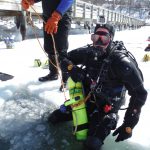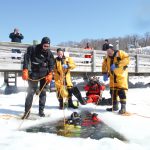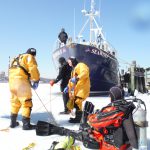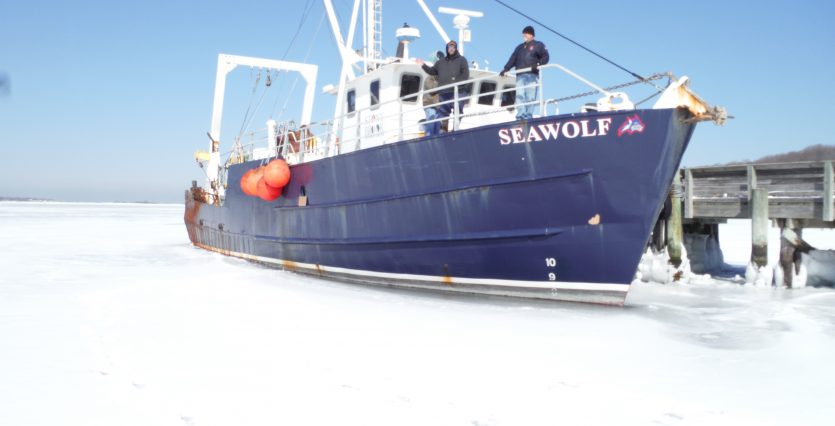Living and diving around Long Island, New York, provides for a wide variety of diving opportunities. The “normal” dive season is about seven months long for the average drysuit diver, but most divers really only utilize the warmest four or five months of the year. Then there’s the other side of the coin: divers who want to be able to get out and dive locally all year-round. Fortunately, we can do just that — not just when the water gets cold, but even when the water gets REALLY cold.
Every year that we have suitable ice, I try to conduct at least one NAUI Recreational Ice Diver course. 2015 was the last winter that we had significant ice, and it was a good one; Lake Ronkonkoma was covered in nearly 0.6 meters (2 feet) of ice for most of the winter.
Recreational ice diving presents its own unique set of challenges, mostly temperature related, and it’s important to make sure that you are thoroughly prepared well in advance of setting foot on the ice. My ice diving course starts off with a couple days of academics, doing a thorough review of drysuit techniques, going over undergarment options and glove systems, and reviewing the ways that we will protect ourselves from the cold, both above and below the ice. With proper preparation, ice diving can be conducted with minimal discomfort. When you really have it all dialed in, you can be downright toasty. I like to tell my students, “If you’re cold, you’re doing it wrong.”
After we finish up with our drysuit studies, we start examining all the personal gear that the students have brought to class to determine whether it will be suitable for use under the ice. Of course, some regulator designs are more suited than others, but most any regulator system can be used successfully in extreme cold environments as long as it is properly serviced and the intermediate pressure is tweaked lower to help reduce the risk of icing. As long as a student’s gear is in good shape, we make necessary adjustments for our upcoming dives. In the classroom, we thoroughly examine all of the gear we are going to use and get each student completely set up with a rig that will withstand the rigors of an extreme cold environment. Anything that the student does not have, such as sling bottles with regulators and ice harnesses and tether lines, is provided. Some students choose to use full face masks with communication systems; these are also serviced and tested to minimize potential issues down the road.
After we have our gear squared away, we go over all of the techniques that we will use to select and establish an ice diving site, and we go over the operational and safety procedures that we will use during actual ice diving operations. During the course, each student will complete a minimum of three ice dives, but we usually try to do five or m ore each, and graduates have the option to continue ice diving with us after the course has been completed — at no additional charge — as long as the ice lasts that season. Graduates are also welcome to come back and participate in future NAUI Recreational Ice Diver courses, again at no charge.
ore each, and graduates have the option to continue ice diving with us after the course has been completed — at no additional charge — as long as the ice lasts that season. Graduates are also welcome to come back and participate in future NAUI Recreational Ice Diver courses, again at no charge.
Such was the case in 2015. After completing a NAUI Recreational Ice Diver course with students Jason Northgard, Todd Brush, Greg Tellone and Jeremy Davila at Lake Ronkonkoma, we were all pretty motivated to continue our ice diving adventures. That’s when I got a call from Capt. Chris Harter, who runs the R/V Seawolf during scientific diving operations that I supervise for Stony Brook University. It seems that for the first time since 1977, the R/V Seawolf’s home port of Port Jefferson Harbor was completely frozen over, and the 140-ton R/V Seawolf was stuck at the dock. Attempts to free her had been fruitless, her Cummins K38 V-12 diesel’s 800 continuous horsepower had only been able to push her about 8 inches through the ice. This I had to see!
The next day, I took a ride over to Port Jeff and did a walk around on the ice surrounding the R/V Seawolf, sure enough, the seawater ice was at least a foot thick and more than strong enough to support an ice diving operation. I quickly got in touch with my students and reached out to previous graduates and experienced ice divers on social media, and we set up a mini expedition for the next weekend.
The next weekend brought beautiful weather, well, for ice diving anyway — brutally cold but sunny and clear. I brought the Nesconset Fire Department Water Rescue Operations truck as a support vehicle, and we had a great group of ice divers and surface support personnel participating, including experienced public safety ice rescue divers Steve Neumann and Frank Laricchia, public safety ice diving tenders Ron Siwulec and Denis Bricker, and Peg Hart of the U.S. Coast Guard Auxiliary operating the OTS wireless underwater comm system. Photographers Don Preus and Ron Monteleone rounded out the team, along with a bunch of curious onlookers standing on the pier.
We quickly selected a spot right in front of the trapped R/V Seawolf, cut a hole in the 36-cenimeter-thick (14-inch-thick) ice, set up communications, hauled out our equipment and started getting geared up. The  crew of the R/V Seawolf had come out to see the show and stood up on the deck watching as we made our preparations. Well, everyone except mate Jason Schweitzer, who was in the galley making fresh coffee, which he proudly served through the galley porthole to anyone who walked up on the ice.
crew of the R/V Seawolf had come out to see the show and stood up on the deck watching as we made our preparations. Well, everyone except mate Jason Schweitzer, who was in the galley making fresh coffee, which he proudly served through the galley porthole to anyone who walked up on the ice.
With all of our preparations and safety checks done, our backup divers took their positions, and our first group of ice divers entered the water. From the hole, it was easy to reach either the pier or the R/V Seawolf to explore underneath, offering very welcome variety to our usual “swim around under the ice” days at Lake Ronkonkoma. Due to the extremely cold water below the ice, there wasn’t any marine life to be seen, but our divers brought up a few trinkets that they found on the bottom, mostly glassware from the local bars. Treasure!

Given that it had been nearly 40 years since the last time that Port Jefferson Harbor completely froze over, we counted ourselves lucky to have had the opportunity to share such an incredible experience. Throughout the course, everyone learned that it is indeed possible to spend a significant amount of time diving under the ice and remain totally comfortable. We completed all of our dives with zero equipment issues and utilized teamwork to ensure that everyone had a safe and enjoyable experience. Our lessons learned will help to make everyone a more comfortable and capable diver all year-round.


